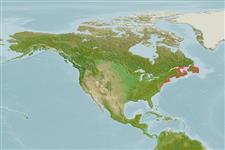Environment: milieu / climate zone / depth range / distribution range
Ökologie
seewasser; süßwasser; brackwasser benthopelagisch; tiefenbereich 0 - 3 m (Ref. 85409). Temperate; 4°C - 20°C (Ref. 2059); 51°N - 35°N
Western Atlantic: Gulf of St. Lawrence in Canada to North Carolina, USA. Mainly a near-shore marine species, but far inland populations occur in lakes in Nova Scotia in Canada and in Hudson, Delaware and Susquehanna River drainages (Ref. 5723).
Size / Gewicht / Alter
Maturity: Lm ? range ? - ? cm
Max length : 6.4 cm TL Männchen/unbestimmt; (Ref. 5723); common length : 4.1 cm TL Männchen/unbestimmt; (Ref. 12193); max. veröff. Alter: 3.00 Jahre (Ref. 12193)
Adults occur mainly along weedy bays and backwaters, entering brackish water and to a limited extent, fresh water (Ref. 3814). Feed along the bottom, primarily on diatoms, worms and crustaceans by sucking in the prey with a pipetting action (Ref. 27549). Males build, guard and aerate the nest where the eggs are deposited (Ref. 205).
Life cycle and mating behavior
Geschlechtsreife | Fortpflanzung | Ablaichen | Eier | Fecundity | Larven
The male builds, guards and aerates the nest (Ref. 205).
Robins, C.R., R.M. Bailey, C.E. Bond, J.R. Brooker, E.A. Lachner, R.N. Lea and W.B. Scott, 1991. Common and scientific names of fishes from the United States and Canada. Am. Fish. Soc. Spec. Publ. (20):183 p. (Ref. 3814)
IUCN Rote Liste Status (Ref. 130435)
Bedrohung für Menschen
Harmless
Nutzung durch Menschen
Aquarium: Öffentliche Aquarien
Mehr Information
ReferenzenAquakulturAquakultur ProfilZuchtlinienGenetikElectrophoresesVererbbarkeitKrankheitenVerarbeitungNutrientsMass conversion
PartnerBilderStamps, Coins Misc.LauteCiguateraGeschwindigkeitSchwimmstilKiemenoberflächeOtolithsGehirngrößeSehfähigkeit
Tools
Zusatzinformationen
Download XML
Internet Quellen
Estimates based on models
Preferred temperature (Ref.
123201): 4.2 - 12.7, mean 6.4 °C (based on 228 cells).
Phylogenetic diversity index (Ref.
82804): PD
50 = 1.0000 [Uniqueness, from 0.5 = low to 2.0 = high].
Bayesian length-weight: a=0.01047 (0.00408 - 0.02689), b=3.07 (2.85 - 3.29), in cm total length, based on LWR estimates for this (Sub)family-body shape (Ref.
93245).
Trophic level (Ref.
69278): 3.2 ±0.38 se; based on food items.
Generation time: 1.3 ( na - na) years. Estimated as median ln(3)/K based on 2
growth studies.
Widerstandsfähigkeit (Ref.
120179): hoch, Verdopplung der Population dauert weniger als 15 Monate. (K=0.84; tmax=3).
Fishing Vulnerability (Ref.
59153): Low vulnerability (16 of 100).
